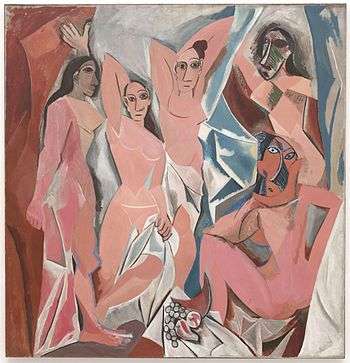Museum of Modern Art
The Museum of Modern Art (MoMA) is an art museum located in Midtown Manhattan, New York City, on 53rd Street between Fifth and Sixth Avenues.
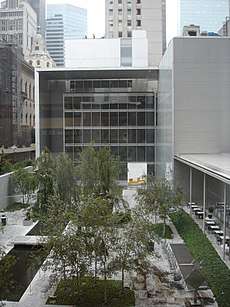 | |

| |
| Established | November 7, 1929 |
|---|---|
| Location | 11 West 53rd Street Manhattan, New York City |
| Coordinates | 40.7616°N 73.9776°W |
| Type | Art museum |
| Visitors | 1,992,121 (2019)[1] |
| Director | Glenn D. Lowry |
| Public transit access | Subway: Fifth Avenue/53rd Street ( Bus: M1, M2, M3, M4, M5, M7, M10, M20, M50, M104 |
| Website | www |
It plays a major role in developing and collecting modern art, and is often identified as one of the largest and most influential museums of modern art in the world.[2] MoMA's collection offers an overview of modern and contemporary art, including works of architecture and design, drawing, painting, sculpture, photography, prints, illustrated books and artist's books, film, and electronic media.[3]
The MoMA Library includes approximately 300,000 books and exhibition catalogs, more than 1,000 periodical titles, and more than 40,000 files of ephemera about individual artists and groups.[4] The archives hold primary source material related to the history of modern and contemporary art.[5]
History
Heckscher and other buildings (1929–39)
The idea for the Museum of Modern Art was developed in 1929 primarily by Abby Aldrich Rockefeller (wife of John D. Rockefeller, Jr.) and two of her friends, Lillie P. Bliss and Mary Quinn Sullivan.[6] They became known variously as "the Ladies" or "the adamantine ladies".[7][8] They rented modest quarters for the new museum in the Heckscher Building at 730 Fifth Avenue in Manhattan,[7] and it opened to the public on November 7, 1929, nine days after the Wall Street Crash.[9] Abby Rockefeller had invited A. Conger Goodyear, the former president of the board of trustees of the Albright Art Gallery in Buffalo, New York, to become president of the new museum. Abby became treasurer. At the time, it was America's premier museum devoted exclusively to modern art, and the first of its kind in Manhattan to exhibit European modernism.[10] One of Rockefeller's early recruits for the museum staff was the noted Japanese-American photographer Soichi Sunami (at that time best known for his portraits of modern dance pioneer Martha Graham), who served the museum as its official documentary photographer from 1930 until 1968.[11][12]
Goodyear enlisted Paul J. Sachs and Frank Crowninshield to join him as founding trustees. Sachs, the associate director and curator of prints and drawings at the Fogg Museum at Harvard University, was referred to in those days as a "collector of curators." Goodyear asked him to recommend a director and Sachs suggested Alfred H. Barr, Jr., a promising young protege. Under Barr's guidance, the museum's holdings quickly expanded from an initial gift of eight prints and one drawing. Its first successful loan exhibition was in November 1929, displaying paintings by Van Gogh, Gauguin, Cézanne, and Seurat.[13]
First housed in six rooms of galleries and offices on the twelfth floor of Manhattan's Heckscher Building,[14] on the corner of Fifth Avenue and 57th Street, the museum moved into three more temporary locations within the next ten years. Abby Rockefeller's husband, John D. Rockefeller, Jr., was adamantly opposed to the museum (as well as to modern art itself) and refused to release funds for the venture, which had to be obtained from other sources and resulted in the frequent shifts of location. Nevertheless, he eventually donated the land for the current site of the museum, plus other gifts over time, and thus became in effect one of its greatest benefactors.[15]
During that time the museum initiated many more exhibitions of noted artists, such as the lone Vincent van Gogh exhibition on November 4, 1935. Containing an unprecedented sixty-six oils and fifty drawings from the Netherlands, as well as poignant excerpts from the artist's letters, it was a major public success due to Barr's arrangement of the exhibit, and became "a precursor to the hold van Gogh has to this day on the contemporary imagination".[16]
53rd Street (1939–present)
1930s and 1940s
The museum also gained international prominence with the hugely successful and now famous Picasso retrospective of 1939–40, held in conjunction with the Art Institute of Chicago. In its range of presented works, it represented a significant reinterpretation of Picasso for future art scholars and historians. This was wholly masterminded by Barr, a Picasso enthusiast, and the exhibition lionized Picasso as the greatest artist of the time, setting the model for all the museum's retrospectives that were to follow.[17] Boy Leading a Horse was briefly contested over ownership with the Solomon R. Guggenheim Museum.[18] In 1941, MoMA hosted the ground-breaking exhibition, "Indian Art of the United States" (curated by Frederic Huntington Douglas and Rene d'Harnoncourt), that changed the way Native American arts were viewed by the public and exhibited in art museums.
When Abby Rockefeller's son Nelson was selected by the board of trustees to become its president, in 1939, at the age of 30; he was a flamboyant leader and became the prime instigator and funding source of MOMA's publicity, acquisitions, and subsequent expansion into new headquarters on 53rd Street. His brother, David Rockefeller, also joined the museum's board of trustees, in 1948, and took over the presidency, when Nelson was elected Governor of New York, in 1958.
David subsequently employed the noted architect Philip Johnson to redesign the museum garden and name it in honor of his mother, the Abby Aldrich Rockefeller Sculpture Garden. He and the Rockefeller family in general have retained a close association with the museum throughout its history, with the Rockefeller Brothers Fund funding the institution since 1947. Both David Rockefeller, Jr. and Sharon Percy Rockefeller (wife of Senator Jay Rockefeller) currently sit on the board of trustees.
In 1937, MoMA had shifted to offices and basement galleries in the Time-Life Building in Rockefeller Center. Its permanent and current home, now renovated, designed in the International Style by the modernist architects Philip L. Goodwin and Edward Durell Stone, opened to the public on May 10, 1939, attended by an illustrious company of 6,000 people, and with an opening address via radio from the White House by President Franklin D. Roosevelt.[19]
1958 fire
On April 15, 1958, a fire on the second floor destroyed an 18-foot (5.5 m) long Monet Water Lilies painting (the current Monet water lilies was acquired shortly after the fire as a replacement). The fire started when workmen installing air conditioning were smoking near paint cans, sawdust, and a canvas dropcloth. One worker was killed in the fire and several firefighters were treated for smoke inhalation. Most of the paintings on the floor had been moved for the construction although large paintings including the Monet were left. Art work on the 3rd and 4th floors were evacuated to the Whitney Museum of American Art, which abutted it on the 54th Street side. Among the paintings that were moved was A Sunday Afternoon on the Island of La Grande Jatte, which had been on loan by the Art Institute of Chicago. Visitors and employees above the fire were evacuated to the roof and then jumped to the roof of an adjoining townhouse.[20]
1960–1982
In 1969, the MoMA was at the center of a controversy over its decision to withdraw funding from the iconic anti-war poster And babies. In 1969, the Art Workers Coalition (AWC), a group of New York City artists who opposed the Vietnam War, in collaboration with Museum of Modern Art members Arthur Drexler and Elizabeth Shaw, created an iconic protest poster called And babies.[21] The poster uses an image by photojournalist Ronald L. Haeberle and references the My Lai Massacre. The Museum of Modern Art (MoMA) had promised to fund and circulate the poster, but after seeing the 2 by 3 foot poster MoMA pulled financing for the project at the last minute.[22][23] MoMA's Board of Trustees included Nelson Rockefeller and William S. Paley (head of CBS), who reportedly "hit the ceiling" on seeing the proofs of the poster.[22] The poster was included shortly thereafter in MoMA's Information exhibition of July 2 to September 20, 1970, curated by Kynaston McShine.[24] Another controversy involved Pablo Picasso's painting Boy Leading a Horse (1905–06), donated to MoMA by William S. Paley in 1964. The status of the work as being sold under duress by its German Jewish owners in the 1930s was in dispute. The descendants of the original owners sued MoMA and the Solomon R. Guggenheim Museum, which has another Picasso painting, Le Moulin de la Galette (1900), once owned by the same family, for return of the works.[25] Both museums reached a confidential settlement with the descendants before the case went to trial and retained their respective paintings.[18][26][27] Both museums had claimed from the outset to be the proper owners of these paintings, and that the claims were illegitimate. In a joint statement the two museums wrote: "we settled simply to avoid the costs of prolonged litigation, and to ensure the public continues to have access to these important paintings."[28]
1980-1999
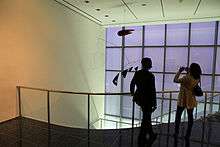
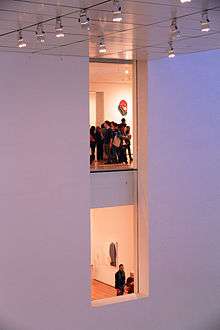
In 1983, the Museum more than doubled its gallery and increased curatorial department by 30 percent, and added an auditorium, two restaurants and a bookstore in conjunction with the construction of the 56-story Museum Tower adjoining the museum.[29]
In 1997, the museum undertook a major renovation and expansion designed by Japanese architect Yoshio Taniguchi with Kohn Pedersen Fox. The project, including an increase in MoMA's endowment to cover operating expenses, cost $858 million in total. The project nearly doubled the space for MoMA's exhibitions and programs and features 630,000 square feet (59,000 m2) of space. The Peggy and David Rockefeller Building on the western portion of the site houses the main exhibition galleries, and The Lewis B. and Dorothy Cullman Education and Research Building provides space for classrooms, auditoriums, teacher training workshops, and the museum's expanded Library and Archives. These two buildings frame the Abby Aldrich Rockefeller Sculpture Garden, which was enlarged from its original configuration.
21st century
The museum was closed for two years in connection with the renovation and moved its public-facing operations to a temporary facility called MoMA QNS in Long Island City, Queens. When MoMA reopened in 2004, the renovation was controversial. Some critics thought that Taniguchi's design was a fine example of contemporary architecture, while many others were displeased with aspects of the design, such as the flow of the space.[30][31][32] In 2005, the museum sold land that it owned west of its existing building to Hines, a Texas real estate developer, under an agreement that reserved space on the lower levels of the building Hines planned to construct there for a MoMA expansion.[33]
In 2011, MoMA acquired an adjacent building constructed and occupied by the American Folk Art Museum on West 53rd Street. The building was a well-regarded structure designed by Tod Williams Billie Tsien Architects and was sold in connection with a financial restructuring of the Folk Art Museum.[34] When MoMA announced that it would demolish the building in connection with its expansion, there was outcry and considerable discussion about the issue, but the museum ultimately proceeded with its original plans.[35]
The Hines building, designed by Jean Nouvel and called 53W53, received construction approval in 2014.[36] Around the time of Hines' construction approval, MoMA unveiled its expansion plans, which encompass space in 53W53, as well as construction on the former site of the American Folk Art Museum.[37] The expansion plan was developed by the architecture firm Diller Scofidio + Renfro in collaboration with Gensler. The first phase of construction began in 2014. In June 2017, patrons and the public were welcomed into MoMA to see the completion of the first phase of the $450 million expansion to the museum.[38]
Spread over three floors of the art mecca off Fifth Avenue are 15,000 square-feet (about 1,400 square-meters) of reconfigured galleries, a new, second gift shop, a redesigned cafe and espresso bar and, facing the sculpture garden, two lounges graced with black marble quarried in France.[38]
The museum expansion project increased the publicly accessibly space by 25% compared to when the Tanaguchi building was completed in 2004.[39] The expansion allowed for even more of the museum's collection of nearly 200,000 works to be displayed.[38] The new spaces also allow visitors to enjoy a relaxing sit-down in one of the two new lounges, or even have a fully catered meal.[38] The two new lounges include "The Marlene Hess and James D. Zirin Lounge" and "The Daniel and Jane Och Lounge".[38][40] The goal of this renovation is to help expand the collection and display of work by women, Latinos, blacks, Asians, and other marginalized communities.[41] In connection with the renovation, MoMA shifted its approach to presenting its holdings, moving away from separating the collection by disciplines such as painting, design and works on paper toward an integrated chronological presentation that encompasses all areas of the collection.[39]
The Museum of Modern Art closed for another round of major renovations from June to October 2019.[41][42] Upon reopening on October 21, 2019, MoMA added 47,000 square feet (4,400 m2) of gallery space,[43] and its total floor area was 708,000 square feet (65,800 m2).[44] The expansion and refurbishment was overseen by the architectural firm of Diller Scofidio + Renfro.[45] The institution began offering free online classes in April 2014.[46]
Exhibition houses
The MoMA occasionally has sponsored and hosted temporary exhibition houses, which have reflected seminal ideas in architectural history.
- 1949: exhibition house by Marcel Breuer
- 1950: exhibition house by Gregory Ain[47]
- 1955: Japanese Exhibition House by Junzo Yoshimura, reinstalled in Philadelphia, PA in 1957–58 and known now as Shofuso Japanese House and Garden
- 2008: Prefabricated houses planned[48][49] by:
- Kieran Timberlake Architects
- Lawrence Sass
- Jeremy Edmiston and Douglas Gauthier
- Leo Kaufmann Architects
- Richard Horden
Artworks
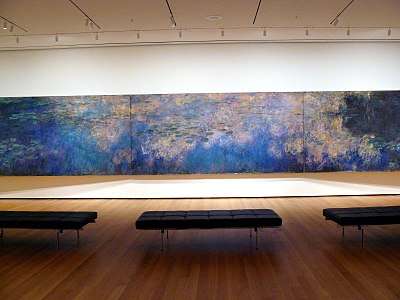
Considered by many to have the best collection of modern Western masterpieces in the world, MoMA's holdings include more than 150,000 individual pieces in addition to approximately 22,000 films and 4 million film stills. (Access to the collection of film stills ended in 2002, and the collection is mothballed in a vault in Hamlin, Pennsylvania.[50]) The collection houses such important and familiar works as the following:
- Francis Bacon, Painting (1946)
- Umberto Boccioni, The City Rises
- Paul Cézanne, The Bather
- Marc Chagall, I and the Village
- Giorgio de Chirico, The Song of Love
- Salvador Dalí, The Persistence of Memory
- Max Ernst, Two Children Are Threatened by a Nightingale
- Paul Gauguin, Te aa no areois (The Seed of the Areoi)
- Albert Gleizes, Portrait of Igor Stravinsky, 1914
- Jasper Johns, Flag
- Frida Kahlo, Self-Portrait With Cropped Hair
- Roy Lichtenstein, Drowning Girl
- René Magritte, The Empire of Lights
- René Magritte, False Mirror
- Kazimir Malevich, White on White 1918
- Henri Matisse, The Dance
- Jean Metzinger, Landscape, 1912–14
- Piet Mondrian, Broadway Boogie-Woogie
- Claude Monet, Water Lilies triptych
- Barnett Newman, Broken Obelisk
- Barnett Newman, Vir Heroicus Sublimis (Man, Heroic and Sublime)
- Pablo Picasso, Les Demoiselles d'Avignon
- Jackson Pollock, One: Number 31, 1950
- Henri Rousseau, The Dream, 1910
- Henri Rousseau, The Sleeping Gypsy
- Vincent van Gogh, The Starry Night
- Andy Warhol, Campbell's Soup Cans
- Andrew Wyeth, Christina's World
Selected collection highlights

 Vincent van Gogh, The Starry Night, 1889
Vincent van Gogh, The Starry Night, 1889 Vincent van Gogh, The Olive Trees with the Alpilles in the Background, 1889
Vincent van Gogh, The Olive Trees with the Alpilles in the Background, 1889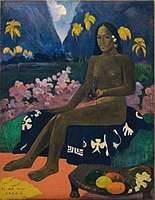

_by_Matisse.jpg) Henri Matisse, The Dance I, 1909
Henri Matisse, The Dance I, 1909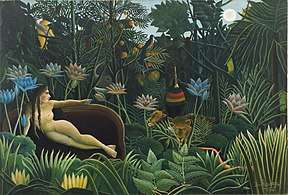 Henri Rousseau, The Dream, 1910
Henri Rousseau, The Dream, 1910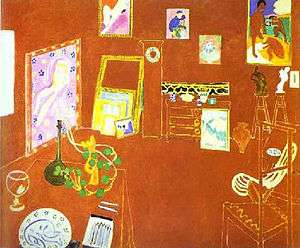 Henri Matisse, L'Atelier Rouge, 1911
Henri Matisse, L'Atelier Rouge, 1911 Marc Chagall, I and the Village, 1911
Marc Chagall, I and the Village, 1911 Umberto Boccioni, 1913, Dynamism of a Soccer Player, 1913, oil on canvas, 193.2 × 201 cm
Umberto Boccioni, 1913, Dynamism of a Soccer Player, 1913, oil on canvas, 193.2 × 201 cm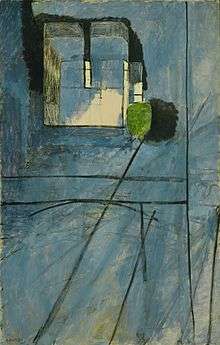 Henri Matisse, View of Notre-Dame, 1914
Henri Matisse, View of Notre-Dame, 1914 Giorgio De Chirico, Love Song, 1914
Giorgio De Chirico, Love Song, 1914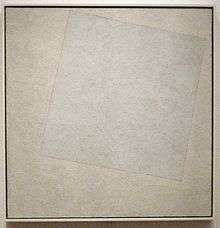
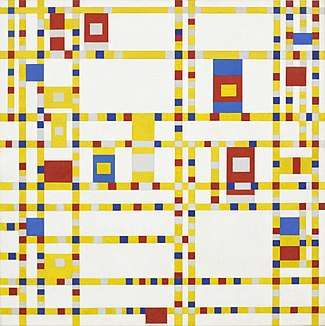 Piet Mondrian, Broadway Boogie Woogie, 1942-1943
Piet Mondrian, Broadway Boogie Woogie, 1942-1943
It also holds works by a wide range of influential European and American artists including Auguste Rodin, Henri Matisse, Pablo Picasso, Georges Braque, Joan Miró, Aristide Maillol, Piet Mondrian, Marcel Duchamp, Paul Klee, Fernand Léger, René Magritte, Henry Moore, Alberto Giacometti, Georgia O'Keeffe, Edward Hopper, Walker Evans, Dorothea Lange, Arshile Gorky, Hans Hofmann, Franz Kline, Willem de Kooning, Jackson Pollock, Mark Rothko, David Smith, Helen Frankenthaler, Morris Louis, Kenneth Noland, Robert Rauschenberg, Frank Stella, Andy Warhol, Roy Lichtenstein, and hundreds of others.
MoMA developed a world-renowned art photography collection first under Edward Steichen (1947-1961) and then under Steichen's hand-picked successor John Szarkowski (1962-1991), which included photos by Todd Webb.[51] The department was founded by Beaumont Newhall in 1940.[52] Under Szarkowski, it focused on a more traditionally modernist approach to the medium, one that emphasized documentary images and orthodox darkroom techniques.
Film
In 1932, museum founder Alfred Barr stressed the importance of introducing "the only great art form peculiar to the twentieth century" to "the American public which should appreciate good films and support them". Museum Trustee and film producer John Hay Whitney became the first chairman of the Museum's Film Library from 1935 to 1951. The collection Whitney assembled with the help of film curator Iris Barry was so successful that in 1937 the Academy of Motion Pictures Arts and Sciences commended the Museum with an award "for its significant work in collecting films ... and for the first time making available to the public the means of studying the historical and aesthetic development of the motion picture as one of the major arts".[53]
The first curator and founder of the Film Library was Iris Barry, a British film critic and author, whose three decades of pioneering work in collecting films and presenting them in coherent artistic and historical contexts gained recognition for the cinema as the major new art form of our century. Barry and her successors have built a collection comprising some eight thousand titles today, concentrating on assembling an outstanding collection of the important works of international film art, with emphasis being placed on obtaining the highest-quality materials.[54]
The exiled film scholar Siegfried Kracauer worked at the MoMA film archive on a psychological history of German film between 1941 and 1943. The result of his study, From Caligari to Hitler: A Psychological History of the German Film (1947), traces the birth of Nazism from the cinema of the Weimar Republic and helped lay the foundation of modern film criticism.
Under the Museum of Modern Art Department of Film, the film collection includes more than 25,000 titles and ranks as one of the world's finest museum archives of international film art. The department owns prints of many familiar feature-length movies, including Citizen Kane and Vertigo, but its holdings also contains many less-traditional pieces, including Andy Warhol's eight-hour Empire, Fred Halsted's gay pornographic L.A. Plays Itself (screened before a capacity audience on April 23, 1974), various TV commercials, and Chris Cunningham's music video for Björk's All Is Full of Love.
Library
The MoMA library is located in Midtown Manhattan, with offsite storage in Long Island City, Queens. The non-circulating collection documents modern and contemporary art including painting, sculpture, prints, photography, film, performance, and architecture from 1880–present. The collection includes 300,000 books, 1,000 periodicals, and 40,000 files about artists and artistic groups. There are over 10,000 artist books in the collection.[55] The libraries are open by appointment to all researchers. The library's catalog is called "Dadabase".[4] Dadabase includes records for all of the material in the library, including books, artist books, exhibition catalogs, special collections materials, and electronic resources.[4] The Museum of Modern Art's collection of artist books includes works by Ed Ruscha, Marcel Broodthaers, Susan Bee, Carl Andre, and David Horvitz.[56]
Additionally, the library has subscription electronic resources along with Dadabase. These include journal databases (such as JSTOR and Art Full Text), auction results indexes (ArtFact and Artnet), the ARTstor image database, and WorldCat union catalog.[55]
Architecture and design
MoMA's Department of Architecture and Design was founded in 1932[57] as the first museum department in the world dedicated to the intersection of architecture and design.[58] The department's first director was Philip Johnson who served as curator between 1932–34 and 1946–54.[59] The next departmental head was Arthur Drexler, who was curator from 1951 to 1956 and then served as head until 1986.[60]
The collection consists of 28,000 works including architectural models, drawings and photographs.[57] One of the highlights of the collection is the Mies van der Rohe Archive.[58] It also includes works from such legendary architects and designers as Frank Lloyd Wright,[61][62][63][64] Paul László, the Eameses, Betty Cooke, Isamu Noguchi, and George Nelson. The design collection contains many industrial and manufactured pieces, ranging from a self-aligning ball bearing to an entire Bell 47D1 helicopter. In 2012, the department acquired a selection of 14 video games, the basis of an intended collection of 40 that is to range from Pac-Man (1980) to Minecraft (2011).[65]
Management
Attendance
MoMA has seen its average number of visitors rise from about 1.5 million a year to 2.5 million after its new granite and glass renovation. In 2009, the museum reported 119,000 members and 2.8 million visitors over the previous fiscal year. MoMA attracted its highest-ever number of visitors, 3.09 million, during its 2010 fiscal year;[66] however, attendance dropped 11 percent to 2.8 million in 2011.[67] Attendance in 2016 was 2.8 million, down from 3.1 million in 2015.[68]
The museum was open every day since its founding in 1929, until 1975, when it closed one day a week (originally Wednesdays) to reduce operating expenses. In 2012, it again opened every day, including Tuesday, the one day it has traditionally been closed.[69]
Admission
The Museum of Modern Art charges an admission fee of $25 per adult.[70] Upon MoMA's reopening, its admission cost increased from $12 to $20, making it one of the most expensive museums in the city. However, it has free entry on Fridays after 5:30pm, as part of the Uniqlo Free Friday Nights program. Many New York area college students also receive free admission to the museum.[71]
Finances
A private non-profit organization, MoMA is the seventh-largest U.S. museum by budget;[72] its annual revenue is about $145 million (none of which is profit). In 2011, the museum reported net assets (basically, a total of all the resources it has on its books, except the value of the art) of just over $1 billion.
Unlike most museums, the museum eschews government funding, instead subsisting on a fragmented budget with a half-dozen different sources of income, none larger than a fifth.[73] Before the economic crisis of late 2008, the MoMA's board of trustees decided to sell its equities in order to move into an all-cash position. An $858 million capital campaign funded the 2002–04 expansion, with David Rockefeller donating $77 million in cash.[72] In 2005, Rockefeller pledged an additional $100 million toward the museum's endowment.[74] In 2011, Moody's Investors Service, a bond rating agency, rated $57 million worth of new debt in 2010 with a positive outlook and echoed their Aa2 bond credit rating for the underlying institution. The agency noted that MoMA has "superior financial flexibility with over $332 million of unrestricted financial resources", and has had solid attendance and record sales at its retail outlets around the city and online. Some of the challenges that Moody's noted were the reliance that the museum has on the tourist industry in New York for its operating revenue, and a large amount of debt. The museum at the time had a 2.4 debt-to-operating revenues ratio, but it was also noted that MoMA intended to retire $370 million worth of debt in the next few years. Standard & Poor's raised its long-term rating for the museum as it benefited from the fundraising of its trustees.[75] After construction expenses for the new galleries are covered, the Modern estimates that some $65 million will go to its $650 million endowment.
MoMA spent $32 million to acquire art for the fiscal year ending in June 2012.[76]
MoMA employed about 815 people in 2007.[73] The museum's tax filings from the past few years suggest a shift among the highest paid employees from curatorial staff to management.[77] The museum's director Glenn D. Lowry earned $1.6 million in 2009[78] and lives in a rent-free $6 million apartment above the museum.[79]
MoMA was forced to close in March 2020 during the COVID-19 pandemic in New York City.[80] Citing the coronavirus shutdown, MoMA fired its art educators in April 2020.[81] In May 2020, it was reported that MoMA would reduce its annual budget from $180 to $135 million starting July 1. Exhibition and publication funding was cut by half, and staff reduced from around 960 to 800.[80]
Key people
Officers and the board of trustees
Currently, the board of trustees includes 46 trustees and 15 life trustees. Even including the board's 14 "honorary" trustees, who do not have voting rights and do not play as direct a role in the museum, this amounts to an average individual contribution of more than $7 million.[77] The Founders Wall was created in 2004, when MoMA's expansion was completed, and features the names of actual founders in addition to those who gave significant gifts; about a half-dozen names have been added since 2004. For example, Ileana Sonnabend's name was added in 2012, even though she was only 15 when the museum was established in 1929.[82]
|
In Memoriam – David Rockefeller (1915–2017)
|
Vice chairmen:
|
Board of trustees
Board of trustees:
|
|
|
|
|
Life trustees:
|
|
Honorary trustees:
|
|
Directors
- Alfred H. Barr, Jr. (1929–1943)
- No director (1943–1949; the job was handled by the chairman of the museum's coordination committee and the director of the Curatorial Department)[83][84]
- Rene d'Harnoncourt (1949–1968)
- Bates Lowry (1968–1969)
- John Brantley Hightower (1970–1972)
- Richard Oldenburg (1972–1995)
- Glenn D. Lowry (1995–present)
Chief curators
- Philip Johnson, chief curator of architecture and design (1932-1934 and 1946-1954)
- Arthur Drexler, chief curator of architecture and design (1951-1956)
- Peter Galassi, chief curator of photography (1991–2011)[52][85]
- Cornelia Butler, chief curator of drawings (2006–2013)
- Barry Bergdoll, chief curator of architecture and design (2007–2013)
- Rajendra Roy, chief curator of film (2007–present)
- Ann Temkin, chief curator of painting and sculpture (2008–present)[86]
- Klaus Biesenbach, director of MoMA PS1 and chief curator at large (2009–2018)
- Sabine Breitwieser, chief curator of media and performance art (2010–2013)
- Christophe Cherix, chief curator of prints and illustrated books (2010–2013), drawings and prints (2013–present)
- Paola Antonelli, director of research and development and senior curator of architecture and design (2012–present)
- Quentin Bajac, chief curator of photography (2012–2018)
- Stuart Comer, chief curator of media and performance art (2014–present)
- Martino Stierli, chief curator of architecture and design (2015–present)
See also
References
Citations
- Sharpe, Emily; José Da Silva (March 31, 2020). "Art's Most Popular: here are 2019's most visited shows and museums". The Art Newspaper. Retrieved July 23, 2020.
- Kleiner, Fred S.; Christin J. Mamiya (2005). "The Development of Modernist Art: The Early 20th Century". Gardner's Art through the Ages: The Western Perspective. Thomson Wadsworth. p. 796. ISBN 978-0-4950-0478-3. Archived from the original on May 10, 2016.
The Museum of Modern Art in New York City is consistently identified as the institution most responsible for developing modernist art ... the most influential museum of modern art in the world.
- Museum of Modern Art – New York Art World Archived February 23, 2009, at the Wayback Machine
- "Library". MoMA. Archived from the original on February 5, 2016.
- "About the Archives". MoMA. Archived from the original on February 13, 2016.
- "The Museum of Modern Art". The Art Story. Archived from the original on March 20, 2015. Retrieved May 12, 2015.
- Meecham, Pam; Julie Sheldon (2000). Modern Art: A Critical Introduction. Psychology Press. p. 200. ISBN 978-0-415-17235-6.
- Dilworth, Leah (2003). Acts of Possession: Collecting in America. Rutgers University Press. p. 183. ISBN 978-0-8135-3272-1.
- Grieveson, Lee; Haidee Wasson (November 3, 2008). Inventing Film Studies. Duke University Press. p. 125. ISBN 978-0-8223-8867-8.
- FitzGerald, Michael (January 1, 1996). Making Modernism: Picasso and the Creation of the Market for Twentieth-Century Art (reprint ed.). Berkeley: Univ of Calif Press. p. 120. ISBN 978-0520206533. Retrieved July 25, 2020.
Before the founding of the Museum of Modern Art in 1929, hardly any institution in the country—and none in Manhattan—would exhibit European modernism.
- Muir, Kathy. "Soichi Sunami". Seattle Camera Club. Retrieved December 31, 2014.
- Smith, Roberta (September 11, 2015). "Review: Picasso, Completely Himself in 3 Dimensions". The New York Times. Archived from the original on December 6, 2015. Retrieved December 3, 2015.
- Harr, John Ensor; Peter J. Johnson (1988). The Rockefeller Century: Three Generations of America's Greatest Family. New York: Charles Scribner's Sons. pp. 217–18. ISBN 978-0684189369.
- Horsley, Carter B. "The Crown Building (formerly the Heckscher Building)". The City Review. Archived from the original on March 8, 2016.
- Kert, Bernice (1993). Abby Aldrich Rockefeller: The Woman in the Family. New York: Random House. pp. 21, 376, 386. ISBN 978-0812970449.
- Kert 1993, p. 376.
- FirzGerald 1996, pp. 243–62.
- Vogel, Carol (December 8, 2007). "Two Museums Go to Court Over the Right to Picassos". The New York Times. Archived from the original on July 1, 2017.
- "Art: Beautiful Doings". Time. May 22, 1939. Archived from the original on January 29, 2008.
- Allen, Greg (September 2, 2010). "MOMA on Fire". the making of: movies, art, &c. Archived from the original on January 22, 2014. Retrieved July 25, 2020.
- Holsinger, M. Paul, ed. (1999). "And Babies". War and American Popular Culture: A Hisstorical Encyclopedia. Greenwood Press. p. 363. ISBN 978-0313299087. Archived from the original on May 12, 2016.
- Frascina, Francis. Art, Politics, and Dissent: Aspects of the Art Left in Sixties America. Manchester Univ Press. p. 175–186. ISBN 978-0719044694. Archived from the original on June 10, 2016.
- Sela, Peter Howard; Susan Landauer (January 9, 2006). Art of Engagement: Visual Politics in California and Beyond. Univ of California Press. p. 46. ISBN 978-0520240520. Archived from the original on June 10, 2016.
- Allan, Kenneth R. (December 15, 2003). "Understanding Information". In Corris, Michael (ed.). Conceptual Art, Theory, Myth, and Practice. Cambridge: Cambridge University Press. pp. 147–148. ISBN 978-0521823883.
- "Pablo Picasso, Le Moulin de la Galette (1900)". Solomon R. Guggenheim Museum. Archived from the original on April 23, 2017.
- Itzkoff, Dave (June 19, 2009). "Judge Rebukes Museums for Secret Picasso Settlement". The New York Times. Archived from the original on July 9, 2017.
- Kearney, Christine (February 2, 2009). "NY museums settle in claim of Nazi-looted Picassos". Reuters. Archived from the original on December 1, 2017.
- "Guggenheim Settles Litigation and Shares Key Findings" (Press release). Guggenheim Museum. March 25, 2009. Archived from the original on December 1, 2017.
- "Museum of Modern Art Expansion". Pelli Clarke Pelli Architects. Archived from the original on January 26, 2016. Retrieved July 25, 2020.
- Updike, John (November 15, 2004). "Invisible Cathedral". The New Yorker. Archived from the original on September 26, 2014. Retrieved December 12, 2010.
Nothing in the new building is obtrusive, nothing is cheap. It feels breathless with unspared expense. It has the enchantment of a bank after hours, of a honeycomb emptied of honey and flooded with a soft glow.
- Smith, Roberta (November 1, 2006). "Tate Modern's Rightness Versus MoMA's Wrongs". The New York Times. Archived from the original on October 14, 2007. Retrieved February 27, 2007.
The museum's big, bleak, irrevocably formal lobby atrium ... is space that the Modern could ill afford to waste, and such frivolousness continues in its visitor amenities: the hard-to-find escalators and elevators, the too-narrow glass-sided bridges, the two-star restaurant on prime garden real estate where there should be an affordable cafeteria ...Yoshio Taniguchi's MoMA is a beautiful building that plainly doesn't work.
- Rybczynski, Witold (March 30, 2005). "Street Cred: Another Way of Looking at the New MOMA". Slate. Archived from the original on January 20, 2012. Retrieved February 27, 2007.
- Vogel, Carol (January 3, 2007). "MoMA to Gain Exhibition Space by Selling Adjacent Lot for $125 Million". The New York Times. Archived from the original on November 16, 2017. Retrieved November 8, 2017.
- Taylor, Kate (May 10, 2011). "MoMA to Buy Building Used by Museum of Folk Art". The New York Times. Archived from the original on May 27, 2011. Retrieved September 25, 2014.
- Pogrebin, Robin (April 1, 2014). "Architects Mourn Former Folk Art Museum Building". The New York Times. Archived from the original on November 9, 2017.
- "53W53/MoMA Tower/Tower Verre Finally Going Up". citty.com. Archived from the original on May 23, 2015. Retrieved May 28, 2015.
- Pogrebin, Robin (January 8, 2014). "A Grand Redesign of MoMA Does Not Spare a Notable Neighbor". The New York Times. Archived from the original on July 9, 2014. Retrieved September 29, 2014.
- "MoMA expanding its Manhattan space, view of NYC outdoors". WTOP News. Associated Press. June 2, 2017. Archived from the original on January 15, 2018. Retrieved January 16, 2018.
- Pogrebin, Robin (June 1, 2017). "MoMA's Makeover Rethinks the Presentation of Art". The New York Times. Archived from the original on November 9, 2017. Retrieved November 8, 2017.
- Gannon, Devin (May 1, 2017). "MoMA reveals final design for $400M expansion". 6sqft. Archived from the original on January 16, 2018. Retrieved January 16, 2018.
- Pogrebin, Robin (February 5, 2019). "MoMA to Close, Then Open Doors to More Expansive View of Art". The New York Times. ISSN 0362-4331. Retrieved February 21, 2019.
- Hines, Morgan (October 16, 2019). "'A new MoMA': New York's Museum of Modern Art reopening after $450 million expansion". USA Today. Retrieved November 18, 2019.
- Paybarah, Azi (October 21, 2019). "MoMA Reopening: Everything You Need to Know". The New York Times. ISSN 0362-4331. Retrieved November 18, 2019.
- "MoMA reopens with a $450 million mega-expansion and slick renovation". The Architect's Newspaper. October 16, 2019. Retrieved November 18, 2019.
- Walsh, Niall Patrick (February 6, 2019). "MoMA Releases Opening Date and New Images of Major Diller Scofidio + Renfro Expansion". ArchDaily. Retrieved January 20, 2020.
- Fox, Alex (April 14, 2020). "The Museum of Modern Art Now Offers Free Online Classes". Smithsonian. Retrieved July 25, 2020.
- Denzer, Anthony (2008). Gregory Ain: The Modern Home as Social Commentary. Rizzoli Publications. ISBN 978-0-8478-3062-6. Archived from the original on June 17, 2008. Retrieved May 24, 2008.
- MoMA Announces Selection of Five Architects to Display Prefabricated Homes Outside Museum in Summer 2008
- Pogrebin, Robin (January 8, 2008). "Is Prefab Fab? MoMA Plans a Show". The New York Times. Archived from the original on September 26, 2014. Retrieved May 24, 2008.
- McDonald, Boyd; William E. Jones (2015). Cruising the Movies: A Sexual Guide to Oldies on TV. South Pasadena, Calif: Semiotext(e). p. 31. ISBN 978-1584351719.
- "Todd Webb, 94, Peripatetic Photographer". The New York Times. April 22, 2000. Archived from the original on April 3, 2012. Retrieved October 10, 2010.
- Smith, Roberta (October 12, 1991). "Peter Galassi Is Modern's Photo Director". The New York Times. Archived from the original on November 19, 2010. Retrieved September 25, 2014.
- "History of MoMA Film Collection". MoMA. Archived from the original on October 12, 2012. Retrieved October 13, 2012.
- The Museum of Modern Art, New York, Harry N. Abrams, Incorporated, New York, 1997, p. 527
- "Library Collection FAQ". MoMA. Archived from the original on November 4, 2015.
- "Arcade". New York Art Resources Consortium. Retrieved July 25, 2020.
- Broome, Beth (November 4, 2011). "A Landmark Acquisition for MoMA's Architecture and Design Department". Architectural Record. Archived from the original on September 7, 2015.
- Architecture and Design Archived March 4, 2016, at the Wayback Machine, MoMA, retrieved November 30, 2011
- "Philip Johnson Papers in The Museum of Modern Art Archives, 1995". Archived March 4, 2016, at the Wayback Machine MoMA.
- "Exhibition Records 1980-1989 in The Museum of Modern Art Archives", MoMA. 2016.
- Medina, Samuel (January 24, 2014). "Frank Lloyd Wright Exhibition Set to Open at MoMA". Metropolis. Archived from the original on March 3, 2016.
- Sullivan, Robert. "Urban Design: Frank Lloyd Wright's Archives on View at MoMA". Vogue. Archived from the original on March 3, 2016.
- "Exhibitions: Frank Lloyd Wright and the City: Density vs. Dispersal". MoMA. Archived from the original on October 5, 2015.
- "Frank Lloyd Wright". MoMA. Retrieved July 25, 2020.
- Antonelli, Paola (November 29, 2012). "Video Games: 14 in the Collection, for Starters". MoMA. Archived from the original on November 30, 2012. Retrieved November 30, 2012.
- Orden, Erica (June 29, 2010). "MoMA Attendance Hits Record High". The Wall Street Journal. ISSN 0099-9660. Archived from the original on July 10, 2017. Retrieved June 25, 2020.
- Boroff, Philip (January 12, 2012). "MoMA Visitors Fall, Met Museum's Rise, Led by Blockbusters". Bloomberg News. Archived from the original on January 11, 2015.
- "Visitor figures 2016: Christo helps 1.2 million people to walk on water". The Art Newspaper. Archived from the original on December 23, 2017. Retrieved December 22, 2017.
- Vogel, Carol (September 25, 2012). "MoMA Plans to Be Open Every Day". The New York Times. ISSN 0362-4331. Archived from the original on November 19, 2016. Retrieved June 25, 2020.
- "Locations, hours, and admission". MoMA. Retrieved December 8, 2018.
- "Discounts". MoMA. June 26, 2016. Retrieved December 8, 2018.
- Boroff, Philip (August 10, 2009). "Museum of Modern Art's Lowry Earned $1.32 Million in 2008–2009". Bloomberg News. Archived from the original on October 16, 2012.
- Cohen, Arianne (May 1, 2007). "A Museum". New York. Archived from the original on March 5, 2016. Retrieved June 25, 2020.
- Vogel, Carol (April 13, 2005). "MoMA to Receive Its Largest Cash Gift". The New York Times. ISSN 0362-4331. Archived from the original on September 26, 2013. Retrieved June 25, 2020.
- Kazakina, Katya (April 11, 2012). "S&P Raises Museum of Modern Art's Debt Rating on Management". Bloomberg News. Archived from the original on January 11, 2015.
- Pogrebin, Robin (July 22, 2013). "Qatari Riches Are Buying Art World Influence". The New York Times. ISSN 0362-4331. Retrieved June 25, 2020.
- Eakin, Hugh (November 7, 2004). "MoMA's Funding: A Very Modern Art, Indeed". The New York Times. ISSN 0362-4331. Archived from the original on May 28, 2015. Retrieved June 25, 2020.
- Boroff, Philip (August 1, 2011). "MoMA Raises Admission to $25, Paid Director Lowry $1.6 Million". Bloomberg News. Archived from the original on January 11, 2015.
- Flynn, Kevin; Strom, Stephanie (August 9, 2010). "Plum Benefit to Cultural Post: Tax-Free Housing". The New York Times. ISSN 0362-4331. Archived from the original on April 14, 2017. Retrieved June 25, 2020.
- Kamp, Justin (May 7, 2020). "Museum of Modern Art Slashes Budget and Staff to Weather COVID-19". Artsy. Retrieved June 25, 2020.
- McCarthy, Kelly (April 6, 2020). "Coronavirus exposes vulnerability of NYC museums and museum workers". ABC News. Retrieved June 25, 2020.
- Cohen, Patricia (November 28, 2012). "MoMA Gains Treasure That Met Also Coveted". The New York Times. ISSN 0362-4331. Archived from the original on November 28, 2012. Retrieved June 25, 2020.
- "Promoted to Director Of Modern Art Museum". The New York Times. Archived from the original on July 19, 2014.
- "A.H. Barr Jr. Retires at Modern Museum; Director Since 1929 to Devote His Full Time to Writing on Art". The New York Times. October 28, 1943. Archived from the original on July 22, 2014.
- Peces, Juan (February 12, 2018). "The definitive Brassaï show, curated by ex-MoMA star Peter Galassi". British Journal of Photography. Retrieved July 25, 2020.
- Smith, Jennifer (March 23, 2016). "MoMA Serves Up a New '60s Mix". The Wall Street Journal. Retrieved June 26, 2020.
Sources
- Allan, Kenneth R. "Understanding Information", in Conceptual Art: Theory, Myth, and Practice. Ed. Michael Corris. Cambridge: Cambridge University Press, 2004. pp. 144–168.
- Barr, Alfred H; Sandler, Irving; Newman, Amy (January 1, 1986). Defining modern art: selected writings of Alfred H. Barr, Jr. New York: Abrams. ISBN 0810907151.
- Bee, Harriet S. and Michelle Elligott. Art in Our Time. A Chronicle of the Museum of Modern Art, New York 2004, ISBN 0-87070-001-4.
- Fitzgerald, Michael C. Making Modernism: Picasso and the Creation of the Market for Twentieth-Century Art. New York: Farrar, Straus and Giroux, 1995.
- Geiger, Stephan. The Art of Assemblage. The Museum of Modern Art, 1961. Die neue Realität der Kunst in den frühen sechziger Jahren, (Diss. University Bonn 2005), München 2008, ISBN 978-3-88960-098-1.
- Harr, John Ensor and Peter J. Johnson. The Rockefeller Century: Three Generations of America's Greatest Family. New York: Charles Scribner's Sons, 1988.
- Kert, Bernice. Abby Aldrich Rockefeller: The Woman in the Family. New York: Random House, 1993.
- Lynes, Russell, Good Old Modern: An Intimate Portrait of the Museum of Modern Art, New York: Athenaeum, 1973.
- Reich, Cary. The Life of Nelson A. Rockefeller: Worlds to Conquer 1908–1958. New York: Doubleday, 1996.
- Rockefeller, David (2003). Memoirs. New York: Random House. ISBN 978-0812969733.
- Schulze, Franz (June 15, 1996). Philip Johnson: Life and Work. Chicago: University Of Chicago Press. ISBN 978-0226740584.
- Staniszewski, Mary Anne (1998). The Power of Display. A History of Exhibition Installations at the Museum of Modern Art. MIT Press. ISBN 978-0262194020.
- Wilson, Kristina (2009). The Modern Eye: Stieglitz, MoMA, and the Art of the Exhibition, 1925–1934. New Haven: Yale University Press. ISBN 978-0300149166.
- Lowry, Glenn D. (2009). The Museum of Modern Art in this Century. Museum of Modern Art. ISBN 978-0870707643.
External links
| Wikimedia Commons has media related to Museum of Modern Art (New York City). |
- Official website
- MoMA Exhibition History List (1929–Present)
- MoMA Audio
- MoMA's YouTube Channel
- MoMA's free online courses on Coursera
- MoMA Learning
- MoMA Magazine
- Jeffers, Wendy (November 2004). "Abby Aldrich Rockefeller Patron of the modern". Magazine Antiques. 166 (55): 118. 14873617. Retrieved January 28, 2016 – via EBSCOhost.
- " MoMA to Close, Then Open Doors to a More Expansive View of Art" New York Times, 2019
